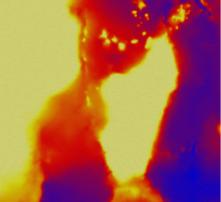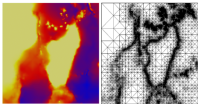Automatic Grid Production for Ocean Modelling
| Working Group: | WG Numerics of PDEs |
| Leadership: | Prof. Dr. Alfred Schmidt ((0421) 218-63851, E-Mail: alfred.schmidt@uni-bremen.de ) |
| Processor: | Dr.-Ing. Jörg Benke |
| Project partner: | Alfred-Wegener-Institut für Polar- & Meeresforschung |
| Time period: | 01.03.2004 - 16.07.2020 |
 In order to be able to investigate the large-scale ocean circulation over a period of several years or decades, the Department of Climate Systems at the Alfred Wegener Institute (AWI) has developed the three-dimensional "Finite Element Ocean Model" (FEOM) [?]. It is based on the equations which govern hydrodynamics (Navier-Stokes equations) as well as the advection-diffusion equations for temperature and salinity. The approximate solution of these model equations is obtained with the aid of the finite element method, appropriate programs are already being used at the AWI and continuously developed. To obtain a better pressure approximation, the three-dimensional grid which underlies the spatial discretisation is semistructured, i.e. the grid comprised of triangular elements on the ocean surface is unstructured (see Fig.), while in the direction of the verticals there is a structured grid made of prisms/ tetrahedra.
In order to be able to investigate the large-scale ocean circulation over a period of several years or decades, the Department of Climate Systems at the Alfred Wegener Institute (AWI) has developed the three-dimensional "Finite Element Ocean Model" (FEOM) [?]. It is based on the equations which govern hydrodynamics (Navier-Stokes equations) as well as the advection-diffusion equations for temperature and salinity. The approximate solution of these model equations is obtained with the aid of the finite element method, appropriate programs are already being used at the AWI and continuously developed. To obtain a better pressure approximation, the three-dimensional grid which underlies the spatial discretisation is semistructured, i.e. the grid comprised of triangular elements on the ocean surface is unstructured (see Fig.), while in the direction of the verticals there is a structured grid made of prisms/ tetrahedra. Since the surface grid, in particular, has previously been generated by hand this project will design an adaptive grid generator which can automatically generate the above-described grid taking into account the complex coastal geometry and the topography of the sea bed. The appropriate local fineness of the grid which is required can be adaptively selected with the help of error estimators to approximate the geometry. Additional criteria guarantee the resolution of important current effects. Starting with a global discretisation of the complete surface of the earth it is thus also possible to select sections from the existing grid or to locally refine them in order to be able to pursue regional studies within a consistent, global model.
Numerous, largely extensive, FEOM computations are necessary to verify the grids generated and for test runs. The FEOM program package is available as both a scalar version and an efficient parallelised version. Simple tests can be performed on an office workstation, more extensive test computations can only be performed within a reasonable time on a cluster.
The simulation of one time step of the FEOM model, which covers two model hours, requires about 15 seconds on modern office workstations. A complete run takes several decades, however. Application computations are therefore performed on the parallel computers at the AWI and on the HLRN super computer. The program scales very well on the nodes available there. A typical computation over a model period of one year requires around 4.5 hours on an IBM Regatta with 8 processors and four times as long on a PC, if sufficient memory (2GB) is available.


